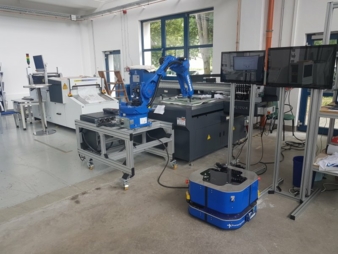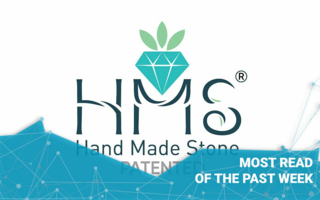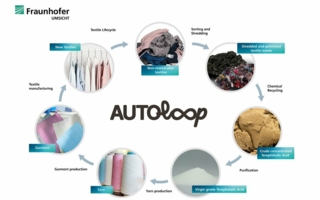11/05/2020 – Robotics in the textile industry – part 3 — auf Deutsch lesen
Mobile robots and grippers for textile substrates
In the third and at the same time last part we take a look at mobile robots and the possibilities of gripping.
Textile substrates in particular present great challenges due to their properties such as air permeability and flexural slackness.
Mobile Robots
Industrial robots are classically used as stationary equipment. However, there are different motivations for their mobile use. New robots for human-robot collaboration (HRC) and lightweight robots are suitable for a mobile version. This can be considered in different stages. Many of them offer great potential for increasing efficiency.
The first stage is the placement of the robot on a mobile frame. Depending on its size and weight, it can be moved to another place and other machines. This allows the robot's utilization to be increased if, for example, the need for loading and unloading at a machine is too small to justify the purchase of a robot.
The next variant involves mounting the robot on a linear axis or a robot positioner. The action space of a robot increases enormously and one can use robots as flexible effectors. This also allows smaller robot sizes while increasing the working space. The linear axis can be controlled as a seventh or external axis in the robot controller. Instead of a linear axis, two or three axes in the other dimensions are also conceivable. Possible applications can be the assembly of several machine tools, packaging systems or the operation of creels.
The third variant, or the maximum technical expansion, is a combination of a robot and an autonomous guided vehicle (AGV). AGVs are mobile platforms, which are mainly used in logistics for material transport. The combination of robot and AGV represents a sophisticated mechatronic system consisting of power supply, drive, safety and data technology. It is the most flexible, but makes high demands on power supply, navigation and positioning.
The power supply can be realized via drag chains or via the accumulators of the AGV. For navigation, the following of a guide wire or magnetic tape, permanent reading of barcodes or evaluation of the data from the safety laser scanners are possibilities.
At the Saxon Textile Research Institute (STFI) e. V., a mobile and versatile robot system is being developed in cooperation with the partners, which consists of a mobile robot system and a driverless transport system. These systems can be used separately from each other to perform handling, processing or transport tasks. For example, the driverless transport system fetches a mobile frame with yarn bobbins, brings them to their destination at a creel and then drives to the robot system to dock and convert it into a mobile robot. The mobile robot system currently under development is being used in the futureTEX research and test area to link finishing and conversion machines by means of automated transport and handling processes.
If mobile robots offer many opportunities for use in production in the future, the current gripper developments are of enormous importance for use in the textile environment.
Gripper systems
Grippers replace the human hand in the automation system and are therefore the key factor for the successful handling of textiles. They are the effector of the robot and form the interface to the workpiece. The need for a large variety of grippers is derived from a large variety of workpieces. But not all grippers are suitable for handling textile materials. Textile materials are dimensionally unstable, limp and permeable to air. In addition, they take up a large surface area in the unrolled state at low thickness. The mass ranges from light to medium weights.
Typical fields of application for robots in textile production can be separating, stacking, positioning and aligning.
In practice, grippers are used either as individual grippers or in combination of individual grippers to form gripping systems. There are also individual special designs, e.g. for the simultaneous handling of several yarn packages.
Special requirements are placed on grippers such as compactness, minimum weight and high clamping and gripping force for use with robots. Grippers can be subdivided according to various criteria, e.g. according to the operating principle such as force, form or material closure.
For the handling of rigid bodies, parallel grippers or finger grippers with two or three gripper jaws have proven themselves in other areas. This allows rigid yarn bobbins to be handled, for example.
Needle grippers can be used for unrolled textiles, e.g. woven or knitted fabrics. Needle grippers vary in the number of needles, the needle stroke and different needle sizes. The pairs of needles, driven by pneumatic cylinders or electric lifting magnets, extend diagonally, penetrate the surface and thus get caught in the material. Needle grippers can be used with air-permeable materials. Needle grippers are also suitable for lifting porous materials such as foams. However, needle grippers can also leave permanent puncture marks in the material structure. Here it depends on whether these defects in the structure are acceptable for the further production process.
Flow or suction grippers can be used for air-impermeable materials, e.g. thin foils. These exist as individual flow grippers or in combination as beam or area grippers. The function is based on a pressure difference between the top and bottom sides. The ambient air pressure, which is higher than inside the gripper, presses the material against the gripper. The negative pressure can be generated by vacuum pumps or ejectors.
Formhand Automation GmbH, Braunschweig/Germany, offers a new type of gripper portfolio with its universal gripper pads. These adapt to the individual surface of the workpiece.
Freezing grippers are another possibility for handling textile materials. They belong to the group of adhesion grippers. The contact surface is wetted with a freezing medium and frozen with a cooling element. The ice forms a contact bridge between the surface and the gripper. The loosening takes place by heating and thus thawing the contact surface.
The Fraunhofer Institute for Production Technology IPT has developed a gripper for the handling of semi-finished products with a low flexural strength, which can grip e.g. air-permeable textiles with electrostatically charged films. Attractive forces resulting from the different electrostatic charges of the gripper and the workpiece cause the material to adhere to the gripper.
Bionic grippers, which include various influences from the human and animal world, offer a previously new field, e.g. a humanoid robot hand is modelled on the human hand.
The adaptive grippers adapt to the contour of the part to be gripped and can therefore be used multifunctionally. This enables safe and non-destructive gripping even of easily fragile or irregularly shaped workpieces
The integration of tactile sensor technology and image processing vision systems into robot applications offer great potential for optimizing accuracy. The sensors can detect the position and orientation of the textile and transfer correction values to the robot for precise gripping.
Finally, the grippers for human-robot collaboration (HRC) should be mentioned. In addition to the robot, grippers and the workpiece must also be designed safely for HRC applications. The grippers have rounded edges and soft surfaces. In addition, the gripping force must be monitored and limited so that no body parts can be crushed in the event of danger.
In summary, it can be stated that there is a wide range of grippers with different designs and operating principles on the market. Not all grippers are suitable for textiles, but new developments and designs offer opportunities for gripping these fabrics. In any case, it remains exciting to continue to observe this area of technology.
Falko Schubert




